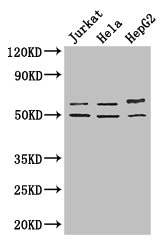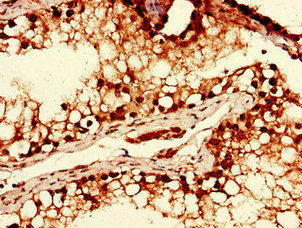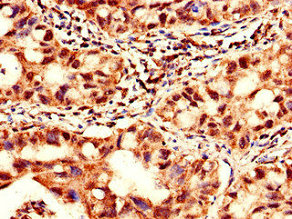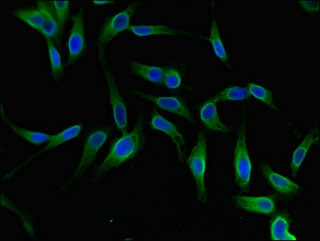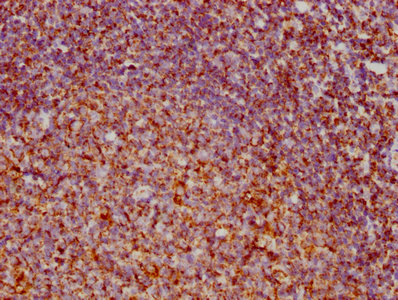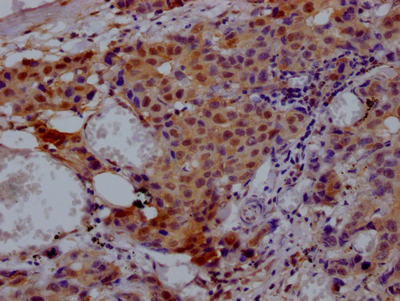YTHDF2 Antibody
-
货号:CSB-PA896902LA01HU
-
规格:¥440
-
促销:
-
图片:
-
Western Blot
Positive WB detected in: Jurkat whole cell lysate, Hela whole cell lysate, HepG2 whole cell lysate
All lanes: YTHDF2 antibody at 2.7μg/ml
Secondary
Goat polyclonal to rabbit IgG at 1/50000 dilution
Predicted band size: 63, 57 kDa
Observed band size: 63, 50 kDa -
Immunohistochemistry of paraffin-embedded human testis tissue using CSB-PA896902LA01HU at dilution of 1:100
-
Immunohistochemistry of paraffin-embedded human lung cancer using CSB-PA896902LA01HU at dilution of 1:100
-
Immunofluorescent analysis of Hela cells using CSB-PA896902LA01HU at dilution of 1:100 and Alexa Fluor 488-congugated AffiniPure Goat Anti-Rabbit IgG(H+L)
-
-
其他:
产品详情
-
产品名称:Rabbit anti-Homo sapiens (Human) YTHDF2 Polyclonal antibody
-
Uniprot No.:Q9Y5A9
-
基因名:YTHDF2
-
别名:9430020E02Rik antibody; CAHL antibody; CLL associated antigen KW 14 antibody; CLL-associated antigen KW-14 antibody; HGRG8 antibody; High glucose regulated protein 8 antibody; High-glucose-regulated protein 8 antibody; NY REN 2 antibody; Renal carcinoma antigen NY REN 2 antibody; Renal carcinoma antigen NY-REN-2 antibody; YTH domain family 2 antibody; YTH domain family member 2 antibody; YTH domain family protein 2 antibody; YTH N6 methyladenosine RNA binding protein 2 antibody; YTHD2_HUMAN antibody; YTHDF 2 antibody; YTHDF2 antibody
-
宿主:Rabbit
-
反应种属:Human
-
免疫原:Recombinant Human YTH domain-containing family protein 2 protein (201-500AA)
-
免疫原种属:Homo sapiens (Human)
-
标记方式:Non-conjugated
本页面中的产品,YTHDF2 Antibody (CSB-PA896902LA01HU),的标记方式是Non-conjugated。对于YTHDF2 Antibody,我们还提供其他标记。见下表:
-
克隆类型:Polyclonal
-
抗体亚型:IgG
-
纯化方式:>95%, Protein G purified
-
浓度:It differs from different batches. Please contact us to confirm it.
-
保存缓冲液:Preservative: 0.03% Proclin 300
Constituents: 50% Glycerol, 0.01M PBS, PH 7.4 -
产品提供形式:Liquid
-
应用范围:ELISA, WB, IHC, IF
-
推荐稀释比:
Application Recommended Dilution WB 1:2000-1:5000 IHC 1:20-1:200 IF 1:50-1:200 -
Protocols:
-
储存条件:Upon receipt, store at -20°C or -80°C. Avoid repeated freeze.
-
货期:Basically, we can dispatch the products out in 1-3 working days after receiving your orders. Delivery time maybe differs from different purchasing way or location, please kindly consult your local distributors for specific delivery time.
相关产品
靶点详情
-
功能:Specifically recognizes and binds N6-methyladenosine (m6A)-containing RNAs, and regulates their stability. M6A is a modification present at internal sites of mRNAs and some non-coding RNAs and plays a role in mRNA stability and processing. Acts as a regulator of mRNA stability by promoting degradation of m6A-containing mRNAs via interaction with the CCR4-NOT and ribonuclease P/MRP complexes, depending on the context. The YTHDF paralogs (YTHDF1, YTHDF2 and YTHDF3) share m6A-containing mRNAs targets and act redundantly to mediate mRNA degradation and cellular differentiation. M6A-containing mRNAs containing a binding site for RIDA/HRSP12 (5'-GGUUC-3') are preferentially degraded by endoribonucleolytic cleavage: cooperative binding of RIDA/HRSP12 and YTHDF2 to transcripts leads to recruitment of the ribonuclease P/MRP complex. Other m6A-containing mRNAs undergo deadenylation via direct interaction between YTHDF2 and CNOT1, leading to recruitment of the CCR4-NOT and subsequent deadenylation of m6A-containing mRNAs. Required maternally to regulate oocyte maturation: probably acts by binding to m6A-containing mRNAs, thereby regulating maternal transcript dosage during oocyte maturation, which is essential for the competence of oocytes to sustain early zygotic development. Also required during spermatogenesis: regulates spermagonial adhesion by promoting degradation of m6A-containing transcripts coding for matrix metallopeptidases. Also involved in hematopoietic stem cells specification by binding to m6A-containing mRNAs, leading to promote their degradation. Also acts as a regulator of neural development by promoting m6A-dependent degradation of neural development-related mRNA targets. Inhibits neural specification of induced pluripotent stem cells by binding to methylated neural-specific mRNAs and promoting their degradation, thereby restraining neural differentiation. Regulates circadian regulation of hepatic lipid metabolism: acts by promoting m6A-dependent degradation of PPARA transcripts. Regulates the innate immune response to infection by inhibiting the type I interferon response: acts by binding to m6A-containing IFNB transcripts and promoting their degradation. May also act as a promoter of cap-independent mRNA translation following heat shock stress: upon stress, relocalizes to the nucleus and specifically binds mRNAs with some m6A methylation mark at their 5'-UTR, protecting demethylation of mRNAs by FTO, thereby promoting cap-independent mRNA translation. Regulates mitotic entry by promoting the phase-specific m6A-dependent degradation of WEE1 transcripts. Promotes formation of phase-separated membraneless compartments, such as P-bodies or stress granules, by undergoing liquid-liquid phase separation upon binding to mRNAs containing multiple m6A-modified residues: polymethylated mRNAs act as a multivalent scaffold for the binding of YTHDF proteins, juxtaposing their disordered regions and thereby leading to phase separation. The resulting mRNA-YTHDF complexes then partition into different endogenous phase-separated membraneless compartments, such as P-bodies, stress granules or neuronal RNA granules. May also recognize and bind RNAs modified by C5-methylcytosine (m5C) and act as a regulator of rRNA processing.; (Microbial infection) Promotes viral gene expression and replication of polyomavirus SV40: acts by binding to N6-methyladenosine (m6A)-containing viral RNAs.; (Microbial infection) Promotes viral gene expression and virion production of kaposis sarcoma-associated herpesvirus (KSHV) at some stage of the KSHV life cycle (in iSLK.219 and iSLK.BAC16 cells). Acts by binding to N6-methyladenosine (m6A)-containing viral RNAs.
-
基因功能参考文献:
- apoptosis ratio of YTHDF2-shRNA-expressing MGC-803 cells was significantly higher compared with the control groups PMID: 29382422
- The s found that the overexpression of YTHDF proteins in cells inhibited HIV-1 infection mainly by decreasing HIV-1 reverse transcription, while knockdown of YTHDF1-3 in cells had the opposite effects. Moreover, silencing the N(6)-methyladenosine writers decreased HIV-1 Gag protein expression in virus-producing cells, while silencing the N(6)-methyladenosine erasers increased Gag expression. PMID: 27371828
- miR-145 modulates N(6)-methyladenosine levels by targeting the 3'-UTR of YTHDF2 mRNA in hepatocellular carcinoma cells PMID: 28104805
- binding affinities of the YTH domains of three human proteins and yeast YTH domain protein Pho92 PMID: 26318451
- The study presents the structure of YTH-YTHDF2 in complex with an N6-methyladenosine mononucleotide. PMID: 25412658
- The basic residues K416 and R527 on the surface of the YTH domain of YTHDF2 are involved in binding to the RNA backbone, and residues W432 and W486 within the hydrophobic pocket contribute to the specific recognition of N6-methyladenosine. PMID: 25412661
- m(6)A is selectively recognized by the human YTH domain family 2 (YTHDF2) 'reader' protein to regulate mRNA degradation PMID: 24284625
- PMID:10508479 reported that AF155095 (clone REN-2) may be involved in signal transduction and the gene is on chromosome 14. It turns out that it is the pseudogene, not the real gene, is located on chromosome 14. PMID: 10508479
- YTHDF2 messenger RNA resulted to be mainly expressed in testis and placenta. The data suggest a possible role of this locus in human longevity. PMID: 16799135
显示更多
收起更多
-
亚细胞定位:Cytoplasm, cytosol. Cytoplasm, P-body. Cytoplasm, Stress granule. Nucleus.
-
蛋白家族:YTHDF2 family
-
组织特异性:Highly expressed in induced pluripotent stem cells (iPSCs) and down-regulated during neural differentiation.
-
数据库链接:
HGNC: 31675
OMIM: 610640
KEGG: hsa:51441
STRING: 9606.ENSP00000362918
UniGene: Hs.532286
Most popular with customers
-
YWHAB Recombinant Monoclonal Antibody
Applications: ELISA, WB, IF, FC
Species Reactivity: Human, Mouse, Rat
-
Phospho-YAP1 (S127) Recombinant Monoclonal Antibody
Applications: ELISA, WB, IHC
Species Reactivity: Human
-
-
-
-
-
VDAC1 Recombinant Monoclonal Antibody
Applications: ELISA, WB, IHC
Species Reactivity: Human, Mouse, Rat
-
VCP Recombinant Monoclonal Antibody
Applications: ELISA, WB, IHC, IF, IP
Species Reactivity: Human, Rat


